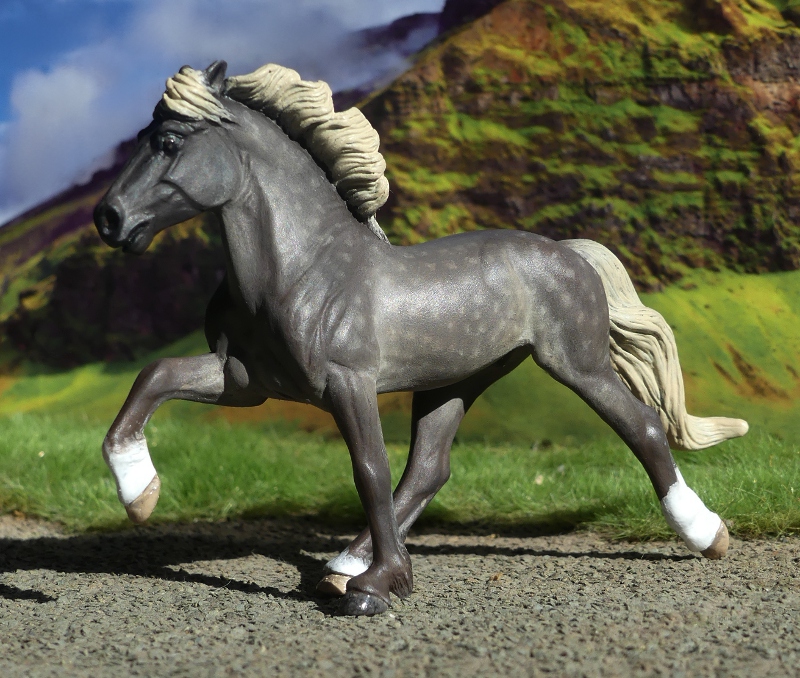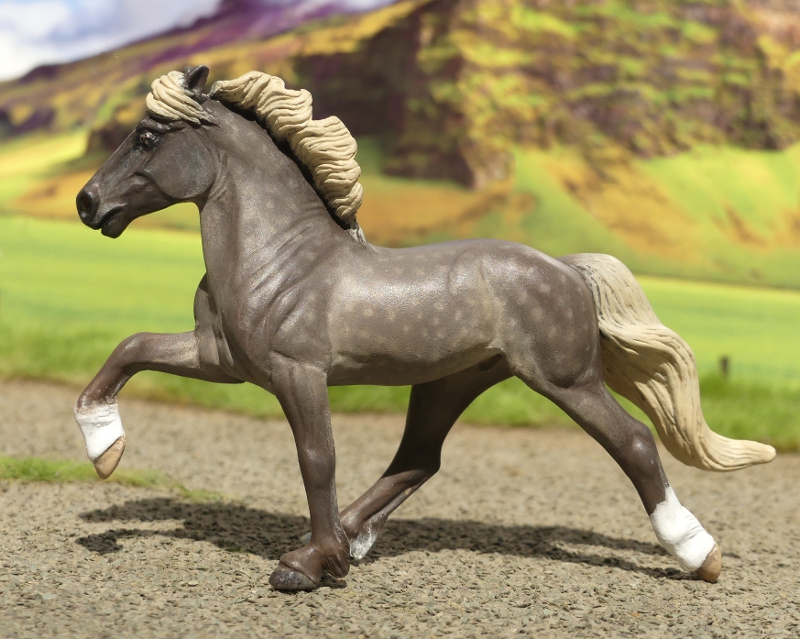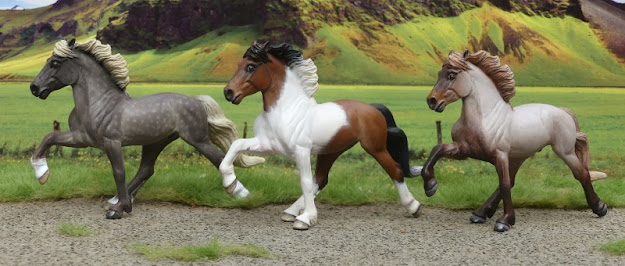I've had some of the great little SM Icelandic mould tucked away in my body box for a while, quietly waiting for their new coats of paint while my colour ideas settled into place. Finally having decided, I got the tins of paint and brushes out, and the result is this little conga line trio of Icelandic horses :
Let's meet them individually, in the order they were painted...

First up, we have Háfleygur, an example of the silver dapple colouration (black, plus the silver gene) which seems more common in the Icelandic than any other pony breed. I'd always wanted to paint one of these, from the moment the mould was released it's been simmering away as something I need to get round to for my collection one day.
These sunnier shots are probably a closer match for how his colour looks in real life, it was hard to get the lighting right so in reality he's somewhere between the two - but I know I put quite a lot of brown tones into the paints as I mixed so he's definitely got this soft, warm tinge rather than being a plain black'n'white-mixed dappled grey!

Háfleygur's name means 'high flying' - I rummaged through several lists of Icelandic-language horse names in search of something silver-themed, but in the end went for something which didn't reference his colour at all!
Jarpskjóni, on the other hand, has a very literal name - it means bay pinto horse! So many Icelandics are named for their colour, markings, or other physical descriptions, it seems fitting to go with tradition and call at least some of my customs after their colouring.
He's another colour which rumbled around in my head for a while before really settling. I'd noticed that the patches on pinto Icelandics sometimes came out with a wide band of white right round the middle, leaving just the head and hindquarters in colour. Of course this can happen in any tobiano, but it seems more common in the Icelandics, so it was an ideal colour custom for the breed. I picked a plain bay to go with it, as we spend so much time focusing on the unusual dun/silver/cream combination colours they can be, the ordinary bays and chestnuts get overlooked.
They're photographed on the bit of Iceland that came inside my Breyer Elska's box! I forgot I had such a fitting background last time I painted some of this mould, but got it out in time for this batch.
As I'd been reading pages about Icelandic horse coat colours, I kept seeing reference to the rare 'colour changing roan', and in the lists of names, I'd see those which translated as colour changer, horse which changes colour, double colour, and even the charmingly quirky literal meaning of two coats or two shirts. Finally, this page shed more light on the colour change phenomenon - a seasonal moult made much more obvious by the white undercoat.
The article also came with a gorgeous photo, so as well as satisfying my curiosity about the colour, it gave me the 'I must paint this!' inspiration for what to do with the last Icelandic mould in my box.
And here he is! It was a really fun colour to recreate, from just one partial photo (I had to guess the lower legs!), trying to get that rough, scumbly mixing of white and dark so it wasn't too smooth and perfect, with the dramatic shading of the base colour in contrast to the body, and the mixed, sun-faded chestnutty blondish mane and tail.
It takes a moment to think what base colour this would be, behind the roaning - if you look back at the real horse the face looks liver chestnut, but the legs are distinctly looking black rather than red. But it can't be a bay - the ginger mane doesn't fit! So I'm assuming a very dark liver chestnut, and left a hint of reddish brown in the paint mix for the legs, rather than going for pure black.
I decided to go with the name Tvíserkur for him, that's the one which translates as 'two shirts', just because it amuses me so much for a horse which changes coat colour like we change between clothes.
And I have to include this unflattering picture just because he looks so wild and ungainly with his eye-white showing and legs in all directions!









No comments:
Post a Comment